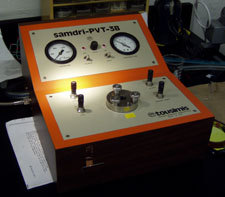Equipment
Critical Point Dryer

Model:
Tousimis PVT-3B Critical Point Dryer
Capabilities:
This tool uses hypercritical techniques to remove water (via transitional fluids) from samples to make them compatible with vacuum equipment (like SEM and TEM). It is also used to perform final drying of MEMS structures to avoid surface tension related artifacts.
Cost:
Calendar for Reservations:
Specifications:
- high pressure liquid CO2 cell with viewing port.
- multiple mesh baskets for sample immobilization.
- simple manual operation
Critical Point Drying (CPD) is a process to remove liquid in a precise and controlled way. It is useful in the production of microelectromechanical systems (MEMS), the drying of spices, the production of aerogel, the decaffeination of coffee and in the preparation of biological specimens for scanning electron microscopy. In normal drying as the substance in a liquid body crosses the boundary from liquid to gas the liquid changes into gas at a finite rate, while the amount of liquid decreases. When this happens within a heterogeneous environment, surface tension in the liquid body pulls against any solid structures the liquid might be in contact with. Delicate structures such as cell walls, the dendrites in silica gel, and the tiny machinery of microelectromechanical devices, tend to be broken apart by this surface tension as the liquid–gas–solid junction moves by. To avoid this, the sample can be brought via two possible alternate paths from the liquid phase to the gas phase without crossing the liquid–gas boundary. In the first, freeze-drying, some structures can still be disrupted even by traversing the solid–gas boundary. Supercritical drying, on the other hand, goes around the critical point. This route from liquid to gas does not cross any phase boundary, instead passing through the supercritical region, where the distinction between gas and liquid ceases to apply. Densities of the liquid phase and vapor phase become equal at critical point of drying.
